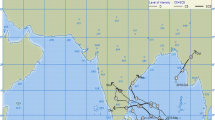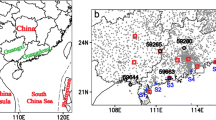Abstract
In order to clarify the characteristics of Mesoscale Convective System (MCS) development and understand the impact of the trigger effect of isolated islands, observational and numerical analysis of the heavy rainfall were carried out over the southwestern part of the Korean Peninsula on July 14, 2004. Satellite based remote sensing data and numerical model MM5 with observational data adjustment were used in this study. The MCS development, in this case, was accompanied not by directional wind shear, but by speed shear which was strongly associated with development of the updraft cloud. An inversion layer at a 750 hPa level is one of the fundamental factors in increasing instability. Effective separation of the upper and lower level atmospheric structure due to an inversion layer at a 750 hPa level creates a suitable condition to develop a MCS. According to numerical analysis it has been found that isolated islands located off the southwestern part of the Korean Peninsula are not a principal factor in causing the heavy rainfall due to the evolution of MCS in this case. Transferable topographic forcing of the downwind side can often induce the variation of MCS intensity, while associated with the precipitation amount over the lee side of the isolated islands at a mature stage of MCS development.
Similar content being viewed by others
References
Baeck, M. L., and J. A. Smith, 1998: Rainfall estimation by the WSR-88D for heavy rainfall events. Wea. Forecasting, 13, 416–436.
Chen, C. S., W. C. Chen, Y. L. Chen, P. L. Lin, and H. C. Lai, 2005: Investigation of orographic effects on two heavy rainfall events over southwestern Taiwan during the Mei-Yu season. Atmos. Res., 73, 101–130.
Cosma, S., E. Richard, and F. Miniscloux, 2002: The role of small-scale orographic features in the spatial distribution of precipitation. Quart. J. Roy. Meteor. Soc., 128, 75–92.
Fuhrer, O., and C. Schar, 2007: Dynamics of orographically triggered banded convection in sheared moist orographic flows. J. Atmos. Sci., 64, 3542–3561.
Grell, G., J. Dudhia, and D. Stauffer, 1995: A description of the fifth-generation Penn State/NCAR Mesoscale Model (MM5). NCAR Tech. Note, NCAR/TN-398+STR, 122 pp.
Hanesiak, J. M., R. L. Raddatz, and S. Lobban, 2004: Local initiation of deep convection on the Canadian Prairie Provinces, Bound.-Layer Meteor., 110, 455–470.
Kim, H. W., and D. K. Lee, 2006: An observational study of mesoscale convective systems with heavy rainfall over the Korean Peninsula. Wea. Forecasting, 21, 125–148.
Lee, D. K., and S. Y. Hong, 1989: Numerical experiments of heavy rainfall event occurred over Korea during 1–3 September 1984. J. Korean Meteor. Soc., 25, 35–41. (in Korean with English abstract)
_____, and H. R. Kim, 1995: Numerical simulation of 10 heavy rainfall cases over the Korean Peninsula. Int. Workshop on Heavy Rainfall in East Asia, Seoul, South Korea, Atmospheric and Environmental Research Institute/Seoul National University and Korea Science and Engineering Foundation, 114–133.
_____, and S. Y. Hong, 1998: Heavy rainfall over Korea during 1980–1990. Korean J. Atmos. Soc., 1, 32–50.
Lee, S. H., and F. Kimura, 2001: Comparative Studies in the local circulations induced by land-use and by topography. Bound.-Layer Meteor., 101, 157–182.
_____, and H. D. Kim, 2008: Effects of regional warming due to urbanization on daytime local circulations in a complex basin of Daegu Metropolitan Area, Korea. J. Appl. Meteor. Climatol., 47, 1427–1441.
Moteki, Q., H. Uyeda, T. Maesaka, T. Shinoda, M., Yoshizaki, and T. Kato, 2004: Structure and development of two merged rainbands observed over the East China Sea during X-BAIU-99 Part I: Meso-β-scale structure and development processes. J. Meteor. Soc. Japan, 82, 19–44.
Ninomiya, K., 2000: Large- and meso-alpha-scale characteristics of Meiyu/ Baiu front associated with intense rainfalls in 1–10 July 1991. J. Meteor. Soc. Japan, 78, 141–157.
Ryu, C. S., Y. M. Shin, and S. H. Lee, 2004: Numerical studies for the effects of complicate coastal area on variation of mesoscale circulation. J. Korean Meteor. Soc., 40, 71–86.
Serafin, R. J., and J. W. Wilson, 2000: Operational weather radar in the United States: Progress and opportunity. Bull. Amer. Meteor. Soc., 81, 501–518.
Sun, J., and T. Y. Lee, 2002: A Numerical study of an intense quasistationary convection band over the Korean Peninsula. J. Meteor. Soc. Japan, 80, 1221–1245.
Suprit, K., and D. Shankar, 2008: Resolving orographic rainfall on the Indian west coast. Int.J.Climat., 28, 6433–657.
Yamada, H., B. Gene, H. Uyeda, and K. Tsukboki, 2007: Thermodynamic impact of the heated landmass on the nocturnal evolution of a cloud cluster over a Meiyu-Baiu front. J. Meteor. Soc. Japan, 85, 663–685.
_____, B. Geng, K. K. Reddy, H. Uyeda, and Y. Fujiyoshi, 2003; Three-dimensional structure of a mesoscale convective system in a Baiufrontal depression generated in the downstream region of the Yangtze river. J. Meteor. Soc. Japan, 81, 1243–1271.
Author information
Authors and Affiliations
Corresponding author
Rights and permissions
About this article
Cite this article
Lee, SH., Hwang, SJ. & Ryu, CS. Observational and numerical analysis of the characteristics of MCS development associated with trigger effect of isolated islands. Asia-Pacific J Atmos Sci 46, 355–367 (2010). https://doi.org/10.1007/s13143-010-1005-0
Received:
Revised:
Accepted:
Published:
Issue Date:
DOI: https://doi.org/10.1007/s13143-010-1005-0




